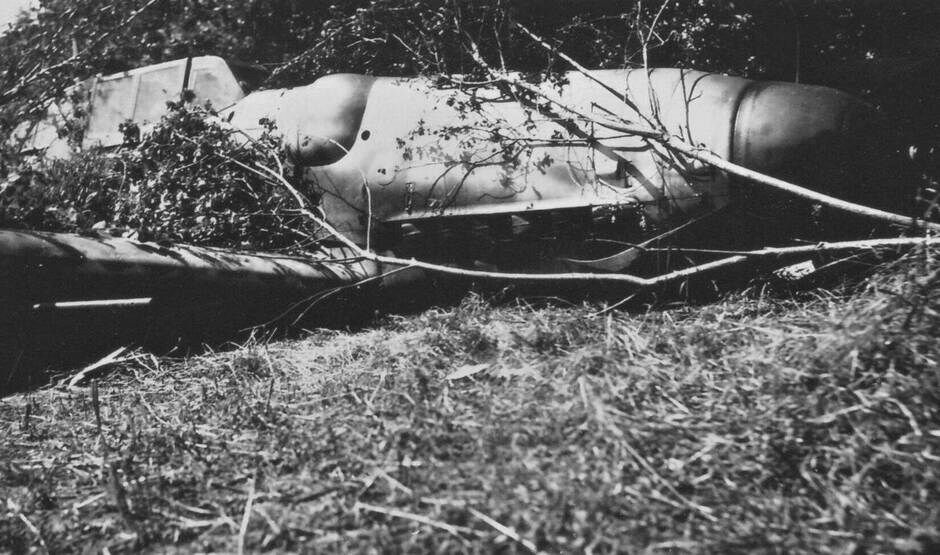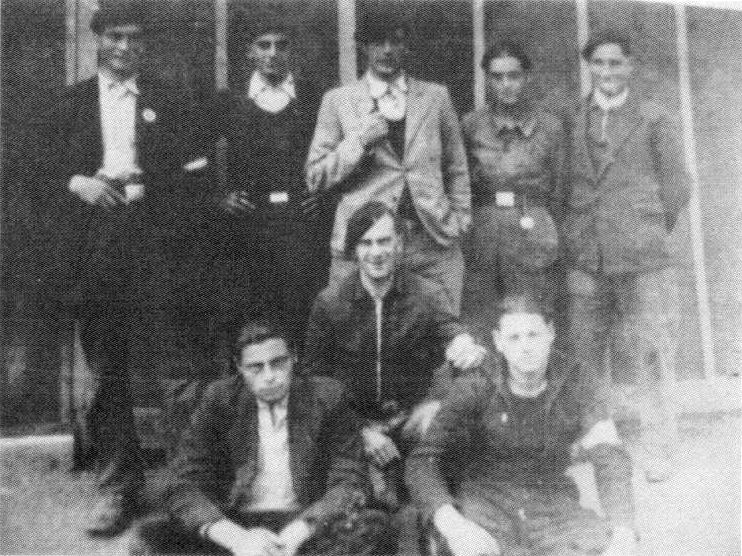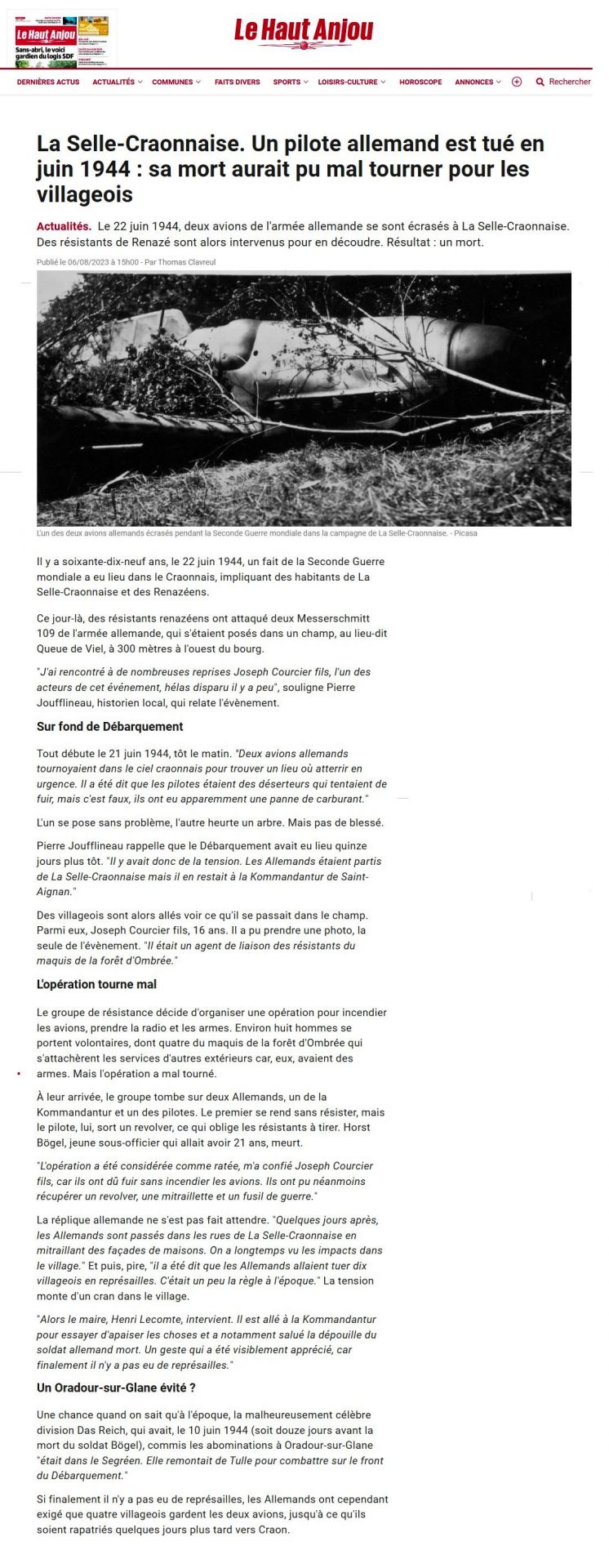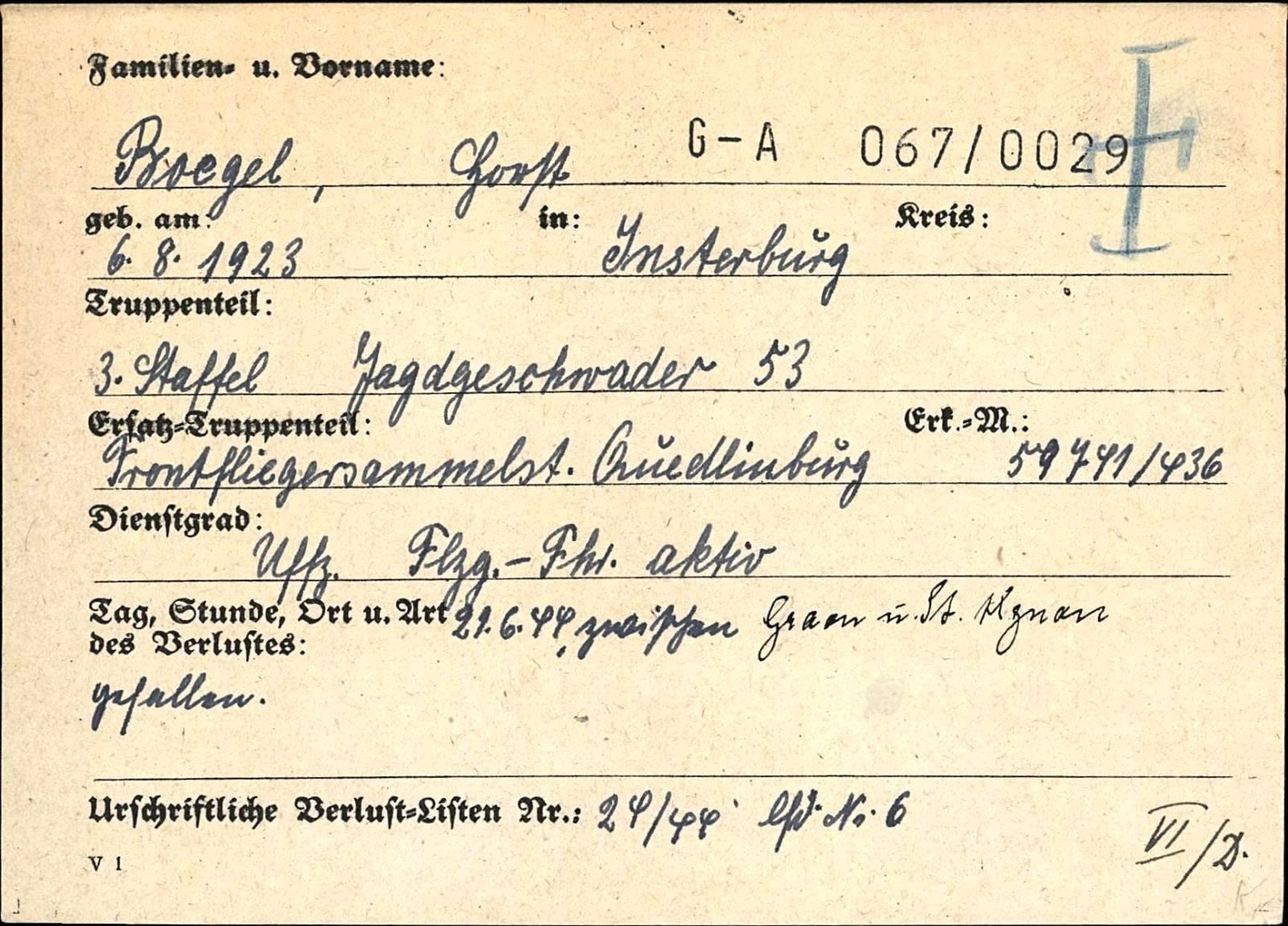Messerschmitt Bf 109 G-6
"La Selle-Craonnaise"
(contributors : Pierre Joufflineau (association Tous en Selle), Philippe Dufrasne)

The Me 109 G-6 fallen at "la Selle-Craonnaise" on June 21, 1944
Photo private collection A. Verdier
Pilot
Unteroffizier Horst BOËGEL - 5./JG 53.
born August 6, 1923 in Instersburg.
Gruft 48, Grabkammer 84, Mont-de-Huisnes
THE STORY
Early in the morning of June 21, 1944, two German Messerschmitt Bf 109 G fighters had to make an emergency landing in a field at the " Queue de Viel " farm, west of " La Selle-Craonnaise". One crashed slightly against a tree, the other landed nearby, arousing the curiosity of the locals who came to observe the aircraft and their pilots, near whom some German soldiers were said to have been standing. In the afternoon, the young resitance liaison officer, Joseph Courcier jr (Renazé maquis) scouted the area to prepare an attack. Then, a group of 8 resistance fighters led by Joseph Courcier (father) attempted to destroy the aircraft and to recover guns. During the action, the pilot Horst Boëgel (21 years old) was shot down, and another German soldier surrendered. One aircraft was partially set on fire and some guns were recovered. In the following days, the Germans reacted and fired on houses in the village, fortunately without causing any casualties. They requisitioned people from La Selle-Craonnaise to guard the planes. Finally, the aircrafts were dismantled and transported by the Germans to Craon.
EXTRACT FROM THE ARTICLE "LA RÉSISTANCE - ATTENTAT DES RÉSISTANTS LE 21 JUIN 1944"
(courtesy of the author, Pierre Joufflineau)
The most significant fact linked to the resistance is of course the event that took place around June 21. All the people of La Selle-Craonnaise were unanimously affected by this episode of the war and the numerous testimonies of the people of La Selle-Craonnaise have made it possible to reconstruct the chronology of this event. First of all, let us Bernard FLAHAUT speak, who wrote the following :
Correspondence of September 2, 2009 between Bernard Flahaut and Pierre Joufflineau.
« … But let's move on to other memories.... You see, there's always a little comic side to the most dramatic situations..... »
« On June 21, 1944, the war arrived in "La Selle-Craonnaise". It must be said that apart from the prisoners in Germany, nothing had changed in the village. That morning, we were at the table in the living room, and the door was wide open : a woman had come for the day. Suddenly, two German aircrafts flew over the farmyard. What was happening ?
By chance, the postman arrived a few hours later and told us that these two aircrafts had landed near the "Queue de Viel" farm. The Internet didn't exist yet...
Of course, the whole family decided to go and see these aircrafts. One of the aircrafts semt intact, the other had lost its wings. The two pilots look amused at the crowd of curious people who had come to admire them. Then we returned to the farm after many discussions with each other.
The next morning, the woman arrives at " Le Plessis", upset and excited. We sat down to eat. "Happy times !" We were eating a roasted goose. Our "cleaning lady" began to recount the evening's events. No one else was able ta say any word ! She met so-and-so who told her that the resistance fighters had mistreated the soldiers ! So-and-so said that one of the airmen was dead ! The Kommandantur has intervened ! We're going to take hostages ! There are going to be people shot ! We're going to hang the town's inhabitants ! We're going to burn everything down...
Terrified, we stood there with our knives in our hands, but this good woman was hungry. One piece of goose, one little comment, and she claimed that all this had ruined her appetite ! Another piece of goose ! Appetite came with eating ! She was excited and kept eating. Her face was all red and greasy. One more piece of goose ! Thank God, she's full, but the goose has had a bad time ! I looked at the pile of bones piling up on her plate ! What if she burst ?
« … But I speak, I speak, just like she ate... I'm not used to writing anymore.... »
This fear mentioned above regarding the maquis attack was really collective. Many of the witnesses interviewed even spoke of the haunting of another "Oradour-sur-Glane". This remark was certainly exaggerated, but it clearly showed this collective fear. It should be noted, however, that the General Lammerding's "Das Reich" division was in the vicinity of Segré at this same time. Lammerding's men were sadly famous for having been the perpetrators of the massacres of Tulle and Oradour-sur-Glane in June 1944, during their return to the Normandy front. We can imagine what would have happened if this terrible SS division had passed through our village at that time ! The Selles-Craonnaise residents did not know it but they could have been really right in mentionning this tragedy of Oradour..
When investigating the circumstances of this operation against the enemy, I met on many occasions a direct witness in the person of Joseph COURCIER1 from Renazé.
At that time, despite he was sixteen, he was a liaison officer for the Renazé maquis. Thanks to their shared memories, here below is the chronology of this event :
- Early in the morning, two Messerschmitt B109G aircrafts circled above the village, apparently looking for an emergency landing spot.
- They landed in a field at the farm " Queue de Viel " located NW of the village. One of the aircraft hit a tree with its right wing. The other landed nearby, 100 m further.
- It was noon when many curious people came to see the aircrafts. The two pilots were also observed near the aircraft. According to other people, other German soldiers were ther (at least one or two). The same day Mr. Albert VERDIER took the photo of the aircraft despite the injunction of the German soldier who ordered him "Nicht photo" (the photo at the beginning of the article).
- Joseph COURCIER Jr., liaison agent in the maquis, came in the afternoon to observe and prepare an attack against the aircrafts.
- Joseph COURCIER, alias "Coulamers", leader of the Renazé maquis, decided to organize an operation. The objective was to set fire to the aircrafts and to capture weapons and equipment.
- A group of 8 men took part in this operation.
The result was :
- UnterOffizer Horst BOGEL2 , one of the pilots was killed during the attack. The other German soldier surrendered to the attackers.
- One of the two aircrafts was partially destroyed.
- A revolver, a machine gun and a war rifle were taken.
A few days later :
- The day after the attack, German soldiers coming from Saint-Aignan machine-gunned the fronts of houses as they entered the village, fortunately without causing any casualties (the bullet holes in the walls of the Pasquier and Duvacher houses were visible for a long time). Henri LECOMTE, mayor at that time, went to the Kommandantur of Saint-Aignan. He took off his hat in front of the pilot's remains, a gesture appreciated by the occupier.
- After the attack, the Germans required that people from La Selle-Craonnaise guarded at night near the aircrafts. Each night, four volunteers participated in this guard for at least a week.
- The two aircrafts were recovered by the German army. Witnesses from La Selle-Craonnaise saw them being transported by truck to Craon. The testimony of Denise M. and Armand M., sister and brother aged 17 and 11 respectively in 1944, gives us additional information : « it was a Sunday, just after mass, and the German trucks passing through the town, loaded with all the parts of the two dismantled aircrafts, were heavily guarded by German soldiers. They pointed their rifles at us as we were leaving mass and they were very threatening. We were scared. The convoy arriving from the bottom of the town took the road to Craon ».
The German interest in these aircrafts was not surprising ; the Messerschmitt Me 109G was a very modern fighter and the Luftwaffe had a crucial need for it, especially at the time of Operation « Overlord ».

Part of the maquis "Courcier" which numbered 50 men at the Liberation.
Raymond CAVALIER (2nd from left in the background) was part of the "Queue de Viel" commando".
Photo collection Pierre Joufflineau
The Renazé maquis was well known in the region for the numerous operations carried out against the enemy, especially from March 1944 ; it was affiliated with the "Libération-Nord3" group of Château-Gontier under the command of COUNORD and MARSOLLIER. Concerning the attack on the "Queue de Viel", Joseph COURCIER acknowledged that this operation was not a complete success ; at first because they were forced to kill the German pilot who refused to surrender, then because the aircrafts were not entirely destroyed and finally because the weapons that were taken were then stolen by suspicious men who had joined them and who disappeared immediately after this raid.
1 After the liberation of the department, he signed a second commitment in the FFI for the duration of the war and was incorporated into the 3rd FFI company of Mayenne. He obtained the title of voluntary resistance fighter on June 11, 1959. He is today vice-president of the association of Voluntary Resistance Fighters of Mayenne and member of the Joint Committee of the Resistance and Deportation Associations of Mayenne and the Souvenir Français. He has been awarded the "Legion d'Honneur" in May 2014.
2 Horst BOËGEL was born on August 6, 1923 in Insterburg (a town in Poland before its annexation by the Reich during the Second World War and then passed under Soviet territory after the end of hostilities in May 1945). Please note the young age of this pilot at the time of the events [21 years old]. He was temporarily buried in the Laval cemetery (source JB FRAPPÉ – 1998).
IN THE PRESS
♦ "Le Haut-Anjou", August 6, 2023

APPENDICES
♦ Death certificate of Horst BOËGEL
(Source document Fold3 "Germany, Military Killed in Action 1939-1948" - origin Bundearchiv - certificat n° G-A 067/0029)

♦ German archive document mentionning the loss of Horst BOËGEL

We learn that Boëgel had been operational for two years, and that the aircraft crashed between Craon and Saint-Aignan (sur Roë),
where La Selle-Craonnaise is located.
Source Pierre JOUFFLINEAU collection
Ajouter un commentaire